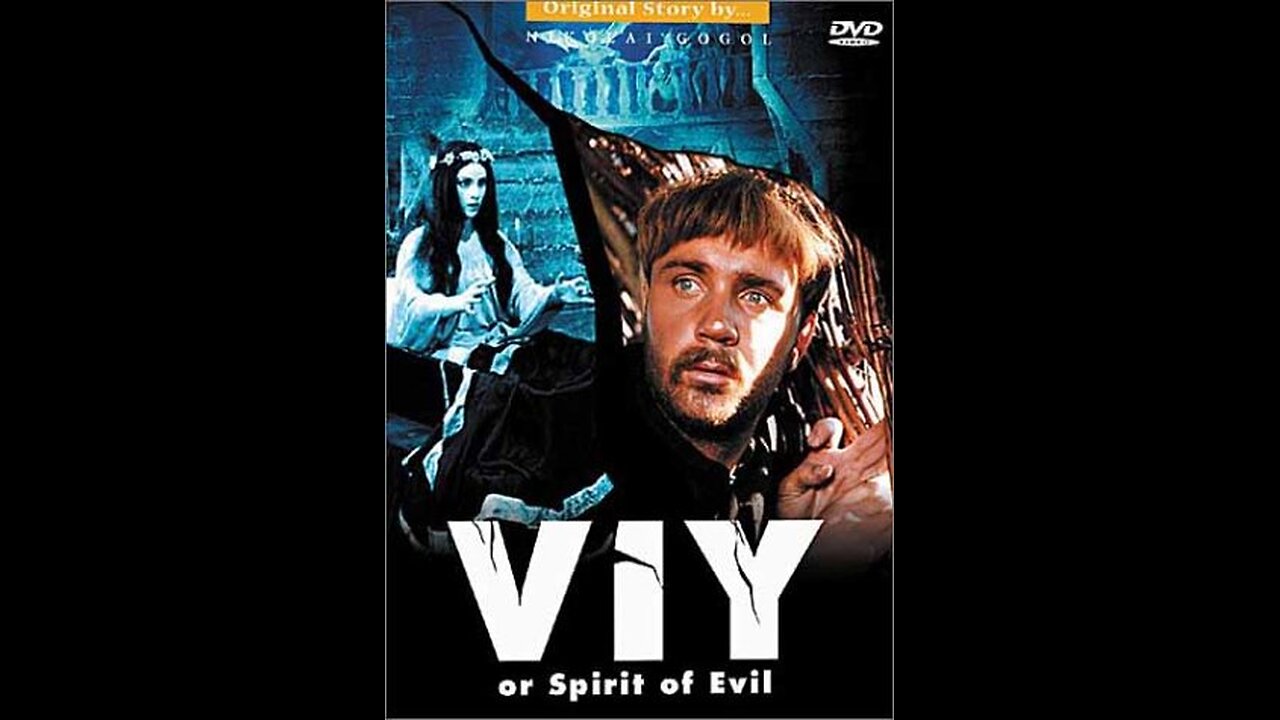Premium Only Content

VIY (1967). In Russian wilth with English subititles
VIY (Spirit of Evil or Vii, Russian: Вий) is a 1967 Soviet supernatural horror film directed by Konstantin Yershov and Georgi Kropachyov. Based on the story of the same name by Nikolai Gogol, the film's screenplay was written by Yershov, Kropachyov and Aleksandr Ptushko. The film was distributed by Mosfilm, and was the first Soviet-era horror film to be officially released in the USSR.
PLOT
As a class of seminary students are sent home for vacation, three of them get lost on the way in the middle of the night. One spots a farmhouse in the distance, and they ask the old woman at the gate to let them spend the night. She agrees, on the condition that they sleep in separate areas of the farm. As one of them, Khoma Brutus, lies down in the barn to sleep, the old woman comes to him and tries to seduce him, which he staunchly refuses. She puts him under a spell and makes him lie down so she can climb on his back. She then rides him around the countryside like a horse. Khoma suddenly finds that they are flying and realizes she is a witch. He demands that she put him back down and, as soon as they land, he grabs a stick and beats her violently. As she cries out that she's dying, he looks and sees she has turned into a beautiful young woman. Horrified, he runs back to his seminary, where he finds the Rector has sent for him. Khoma is told that a rich merchant has a daughter who is dying and needs prayers for her soul, and that she specifically asked for Khoma by name. He refuses to go, but the Rector threatens him with a public beating, so he relents and finds he is returning to the farm where he met the witch. The girl dies before he gets there, and to his horror, he realizes she is the witch, and that he is the cause of her death (but he tells no one). The girl's father promises him great reward if he will stand vigil and pray for her soul for the next three nights. If he does not, grave punishment is implied. After the funeral rites, Khoma is told of a huntsman who fell in love with the young girl, and how when she came into the stable and asked his help to get on her horse, he said he would like it more if she rode on his back, then took her on his back and ran off with her, reminding Khoma of his encounter (the men telling the tale suspect the girl was a witch). He is taken to the chapel where the girl's body lies and is locked in for the night.
As soon as Khoma walks in, several cats scurry across the floor at his feet. He lights every candle in the chapel for comfort, then begins to recite the prayers for the girl's soul. He pauses to sniff tobacco, and when he sneezes, the girl opens her eyes and climbs out of the coffin, blindly searching for him (apparently, she can hear but cannot see). He quickly draws a sacred circle of chalk around himself, and this acts as a barrier, the night passes with Khoma praying fervently and the girl trying to get to him. When the rooster crows in the morning, the girl returns to her coffin and all the candles blow out.
The men of the rich man's estate, who escort Khoma to and from the chapel, surround him and asked what happened that night, to which he replies, "Nothing much. Just some noises".
Khoma gets drunk to strengthen himself for the second night. This time, a flurry of birds fly out from the coffin, startling him into running for the door, which is shut by one of the rich man's men. Khoma returns to the prayer podium and is frightened by a bird flying out his prayer book. He draws the sacred circle again and begins the prayers. The whole covered coffin rises into the air and bangs against the protection of the sacred circle, causing a panicked Khoma to cry out to God to protect him. The cover falls off the coffin, and the girl sits up and again starts reaching blindly to him, but once more, she cannot see him or get to him. The coffin continues to fly around the room as the girl reaches blindly for Khoma and calls his name. As the rooster crows, the coffin returns to its place and the girl lies down, but her voice is heard placing a curse on Khoma, to turn his hair white and render him blind—however, his hair actually turns grey and he retains his sight. The rich man's men have to help him off the floor and out of the chapel, placing a hat on his head. When they return to the farm, Khoma demands music and begins dancing as a young boy plays on his flute. He removes his hat, and all the servants can see his hair is grey. He asks to speak to their master, saying he will explain what happened and that he doesn't want to pray in the chapel any more.
Khoma meets with the rich man, trying to explain what happened in the chapel and begging to be allowed to leave, but the sotnik threatens him with a thousand lashes if he refuses, and a thousand pieces of chervonetses if he succeeds. In spite of this, Khoma tries to escape, but makes a wrong turn and winds up in the hands of the rich man's men, and is returned to the farm.
He returns to the chapel a third time, drunk, but still remembers to draw the sacred circle before beginning the prayers. The girl sits up on the coffin and begins to curse him, causing him to have visions of walking skeletons and grasping, ghostly hands. She summons various hideous, demonic figures to torment him, but they cannot get past the sacred circle either. She finally calls on Viy, a name which causes all the demons to tremble in fear. A large monster emerges, and orders his huge eyelids to be moved from his eyes. Khoma realizes he cannot look this demon in the eye or he is lost. Viy is able to see Khoma, which allows the other demons to pounce on him and beat him, but when the rooster crows once more, the demons all flee away, leaving Khoma motionless on the floor. The girl turns back into the old woman and lies down in the coffin, which instantly falls apart. The Rector enters the chapel to this scene, and races off to tell the others.
The last scene shows Khoma's two friends from the start of the movie back at the seminary, painting some walls. One offers to drink to Khoma's memory, while the other doubts that Khoma is really dead.
The movie follows the original tale in a somewhat loose fashion, but manages to retain the majority of the images and action.
Cast
Leonid Kuravlyov as Khoma Brutus
Natalya Varley as Pannochka[3] (voiced by Klara Rumyanova)
Alexei Glazyrin as sotnik
Vadim Zakharchenko as Khalyava
Nikolai Kutuzov as witch
Pyotr Vesklyarov as Dorosh
Dmitri Kapka as Overko
Stepan Shkurat as Yavtukh
Georgy Sochevko as Stepan
Nikolai Yakovchenko as Spirid
Nikolai Panasyev as comforter
Boryslav Brondukov as bursak
Production
[icon]
This section needs expansion. You can help by adding to it. (November 2014)
Some of the "witch" scenes and the ending where Viy appears were toned down due to technological limitations as well as then current restrictions on Soviet film production. The directors were able to avoid the previous restrictions by using what was considered a "folk tale".
PLOT
In the year 1946, the Soviet space program is undergoing turmoil. Professor Sedikh, who is planning to lead the first crewed exploration to the Moon, is denounced by his rival Professor Karin as being too old and too mentally unstable for the mission. Professor Sedikh, aided by his assistant Marina and a youth named Andryusha, disregard Professor Karin's authority and make a successful landing on the Moon. Although a few problems occur at the Moon, including the discovery of a damaged oxygen tank and Professor Sedikh's becoming trapped under a fallen boulder, the expedition is a success and the cosmonauts return to Moscow.
CAST
Sergei Komarov as Pavel Ivanovich Sedikh
Ksenia Moskalenko as Marina, Karin's assistant
Vassili Gaponenko as Andryusha Orlov
Nikolai Feoktistov as Capt. Viktor Orlov
Vasili Kovrigin as Professor Karin
Andrey Karasyov
Sergey Stolyarov
PRODUCTION
The film was initially conceived in 1924 by Russian filmmaker Vasili Zhuravlov, but it was not pursued for production until 1932, when Komsomol (the Communist Union of Youth) recommended the creation of film that would spur an interest in space studies. Zhuravlov consulted with Konstantin Tsiolkovsky, the noted aeronautical theorist and rocket science engineer, on the screenplay. Tsiolkovsky died shortly after the film was completed.
Two spaceships in the film were named after the Soviet leaders Joseph Stalin and Kliment Voroshilov. The film's cosmonauts enter liquid-filled chambers to buffer the impact of takeoff and landing, and they communicate their landing to the Earth by spelling out "CCCP" (the Russian-language acronym for "USSR") with reflective substances spread across the lunar surface.
Kosmicheskiy reys: Fantasticheskaya novella was shot as a silent film and had only a brief release in early 1936 before being removed from circulation by Soviet censors, who felt that stop-motion animated sequences of cosmonauts hopping across the low-gravity lunar surface were antithetical to the spirit of "socialist realism." It was not widely seen again until the 1980s.
-

Dr Disrespect
9 hours ago🔴LIVE - DR DISRESPECT - MARVEL RIVALS - GOLD VANGUARD
131K27 -
 1:15:00
1:15:00
Awaken With JP
8 hours agoMerry Christmas NOT Happy Holidays! Special - LIES Ep 71
114K100 -
 1:42:21
1:42:21
The Quartering
9 hours agoTrump To INVADE Mexico, Take Back Panama Canal Too! NYC Human Torch & Matt Gaetz Report Drops!
88.9K89 -
 2:23:15
2:23:15
Nerdrotic
9 hours ago $10.10 earnedA Very Merry Christmas | FNT Square Up - Nerdrotic Nooner 453
67.4K6 -
 1:14:05
1:14:05
Tucker Carlson
9 hours ago“I’ll Win With or Without You,” Teamsters Union President Reveals Kamala Harris’s Famous Last Words
150K311 -
 1:58:31
1:58:31
The Dilley Show
9 hours ago $30.88 earnedTrump Conquering Western Hemisphere? w/Author Brenden Dilley 12/23/2024
125K33 -
 1:09:59
1:09:59
Geeks + Gamers
10 hours agoSonic 3 DESTROYS Mufasa And Disney, Naughty Dog Actress SLAMS Gamers Over Intergalactic
88.3K20 -
 51:59
51:59
The Dan Bongino Show
11 hours agoDemocrat Donor Admits The Scary Truth (Ep. 2393) - 12/23/2024
807K2.71K -
 2:32:15
2:32:15
Matt Kohrs
22 hours agoRumble CEO Chris Pavlovski Talks $775M Tether Partnership || The MK Show
121K31 -
 28:23
28:23
Dave Portnoy
22 hours agoDavey Day Trader Presented by Kraken - December 23, 2024
155K43